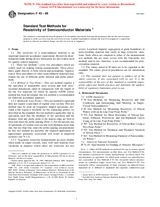We need your consent to use the individual data so that you can see information about your interests, among other things. Click "OK" to give your consent.
ASTM F43-99
Standard Test Methods for Resistivity of Semiconductor Materials (Withdrawn 2003)
STANDARD published on 10.12.1999
The information about the standard:
Designation standards: ASTM F43-99
Note: WITHDRAWN
Publication date standards: 10.12.1999
SKU: NS-55253
The number of pages: 6
Approximate weight : 18 g (0.04 lbs)
Country: American technical standard
Category: Technical standards ASTM
Annotation of standard text ASTM F43-99 :
Keywords:
germanium, resistivity, semiconductor, silicon, ICS Number Code 29.045 (Semiconducting materials)
Additional information
| 1. Scope |
|
This standard was transferred to SEMI (www.semi.org) May 2003 1.1 The resistivity of a semiconductor material is an important materials acceptance requirement. Resistivity determinations made during device fabrication are also widely used for quality control purposes. 1.2 These test methods cover two procedures which are widely used for making routine measurements. These procedures apply directly to both silicon and germanium. Application of these procedures to other semiconductor materials may require the use of different probe material and probe attachment. 1.2.1 Method A, Two-Probe -This test method requires a bar specimen of measurable cross section and with cross-sectional dimensions small in comparison with the length of the bar. For materials for which no specific ASTM referee method has been developed, this test method is recommended for materials acceptance purposes. 1.2.2 Method B, Four-Probe -This test method is rapid and does not require a specimen of regular cross section. This test method may be used on irregularly shaped specimens, provided a flat region is available for the contacting probes. As described in this standard, this test method is applicable only to specimens such that the thickness of the specimen and the distance from any probe point to the nearest edge are both at least four times the probe spacing (Note 1). For the special case of specimens of circular cross section with thickness more than one, but less than four, times the probe spacing, measurements by this test method are possible; the required application of approximate geometric corrections will result in improved accuracy (see 9.1.3). 1.2.3 In general, resistivity measurements are most reliable when made on single crystals, since with such material local variations in impurity which affect the resistivity are less severe. Localized impurity segregation at grain boundaries in polycrystalline material may result in large resistivity variations. Such effects are common to either of the measurement test methods but are more severe with the four-probe test method, and its use, therefore, is not recommended for polycrystalline material. 1.3 The values stated in SI units are to be regarded as the standard. The values given in parentheses are for information only. 1.4 This standard does not purport to address all of the safety problems, if any, associated with its use. It is the responsibility of the user of this standard to establish appropriate safety and health practices and determine the applicability of regulatory limitations prior to use. |
We recommend:
Technical standards updating
Do you want to make sure you use only the valid technical standards?
We can offer you a solution which will provide you a monthly overview concerning the updating of standards which you use.
Would you like to know more? Look at this page.




 Cookies
Cookies
